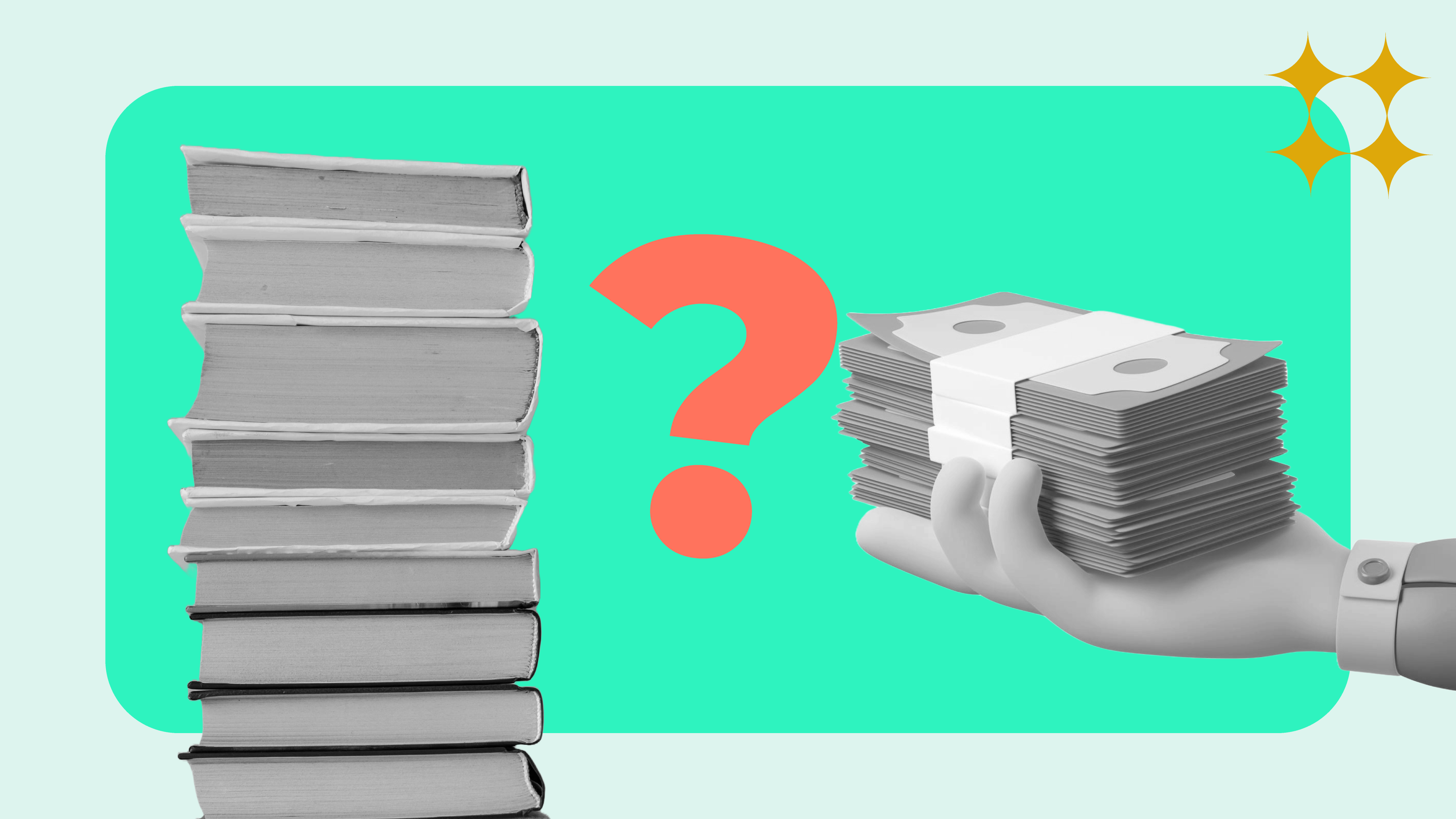Self-Publishing As A Side Hustle: A Writer's Guide

It’s said that everybody’s got a book in them - and increasingly, it seems that everyone’s actually attempting to write it.
Self-publishing has become enormously popular in recent years, as services like Amazon KDP have made it not just possible but positively easy to produce your own published novel.
And although authors are famously poorly paid, self-publishing is also gaining popularity as a side hustle. If you’ve got a way with words and a strong work ethic, it is possible to make a consistent extra income from self-published books.
But how should you get started? Well, reading this article is an excellent first step!
We’ll cover all the basics, from the differences between self-publishing and traditional publishing to the best genres for self-publishing, plus the steps you need to take to start your very own self-publishing side hustle.
Choosing Between Self-Publishing And Traditional Publishing
If you’ve harboured any ambitions to make money as an author, you probably already know the essential differences between self-publishing and traditional publishing - but just in case, we’ll give you a quick rundown.
Traditional publishing means that your work is published by a publishing company (like Bloomsbury or Random House), which pays you for your work.
Usually, the author receives an advance when they sign a book deal with their publisher, and they’re then paid royalties (typically between 7.5% and 10%) on book sales.
Self-publishing means that you publish your work yourself, usually through a third party service such as Amazon.
You pay for all the expenses of publishing yourself (including editing and design work), but you keep all the proceeds of a sale, except for any commission paid to the company hosting your book.
Before the internet, self-publishing was much more difficult, but in recent years it’s exploded in popularity.
It can be somewhat looked down on by traditionally published authors, but as more and more self-published authors enjoy success, often with much better returns than traditionally published authors receive, that’s changing rapidly.
So which should you choose? Well, that depends on what you’re aiming for.
If you’re looking for a side hustle
As a side hustle, self-publishing is the obvious choice. Traditional publishing is a long, long process, with no guarantee of ever having your work published at all.
If you want to make money in the short or medium term, self-publishing is the only sensible choice (though you should be aware that financial success is by no means guaranteed).
If you want a career as an author
If your ambition is eventually to become a professional author, it’s less clear cut. Many people prefer the traditional publishing route, partly for the prestige, but also because their publisher then takes care of everything like editing, marketing, and design on their behalf, leaving them to focus on writing.
However, self-published career authors are increasing in number. If you’re planning to write in genres that are well-suited to self-publishing (see below for examples of these), you may well find that self-publishing suits you best, even if your long-term plan is to write for a living.
How To Get Started With Self-Publishing As A Side Hustle

1. Research. When starting a side hustle, it’s always best to do your research first of all. You should look at the current self-publishing landscape (Amazon KDP being your first port of call) to establish what’s selling well, how it’s marketed, any particular trends in subject matter or design, and where there might be a gap in the market.
2. Choose a niche. Based on your research, and also on what you think you’d be good at writing, decide on a niche to write in. Niches are often very specific (e.g. ‘Billionaire romance’ is an established and highly popular niche), so you should be certain you’ll have plenty of ideas for future books once you’ve settled on one.
3. Decide on your first premise. Having settled on a niche, you need to work out a premise for your first book. Hopefully, you’ll already have some ideas from the process of choosing your niche.
4. Write your book. Now the real work begins. Writing a novel is no small task, especially if it’s your first one. Most novels are at least 50,000 words, and can be up to 100,000 or more for some genres, so the writing is likely to take you some time. You’ll need to establish a regular writing routine and be disciplined about sticking to it.
5. Edit your book, and commission or design a cover. Your book will need extensive editing. It’s a good idea to employ a professional editor, especially for your first book, to ensure that your plot and characterisation both work, and to check for spelling and grammar.
Having produced a clean copy, you’ll also need to design your cover. While you can do this yourself, especially if you’ve got some experience in design work, it’s a good idea to hire a cover designer to avoid an amateurish look.
6. Publish your book. When deciding where to publish their book, most people choose Amazon, and for good reason: it’s got an enormous audience, and tons of tools for making self-publishing easier. However, there are other options out there, so it’s worth taking a look at the alternatives before making your decision.
7. Market your book. Now for the hard bit. You need to get the word out there, as quickly as possible. Use any social media platforms you have available, and consider taking out adverts on websites like Facebook. If you can garner a good number of sales quickly, Amazon will display your book more prominently, which will further improve your sales.
8. Start writing the next one. There’s no rest for a self-published author! To capitalise on the success of your first novel, you need a second ready as soon as possible. You shouldn’t waste any time in repeating this process for a second book, with the aim of building momentum for your burgeoning side hustle.
What Are The Best Genres For Self-Publishing As A Side Hustle?
Not all genres of book are equally well-suited to self-publishing. If you’re writing a literary masterpiece, for example, self-publishing is unlikely to go well, no matter the quality of your prose.
Some of the best genres for self-publishing are as follows:
- Romance (including erotica)
- Sci Fi
- Fantasy
- Mystery, Thriller and Suspense
- Non-Fiction (especially niche subjects and self-help)
In the first four cases, your primary audience reads a lot, and is likely to binge through an author’s entire body of work if they like the first book they read.
With non-fiction, meanwhile, self-publishing success often rests on an existing following, which can be relied on to purchase anything the author writes.
More literary works, including book club/upmarket fiction and literary fiction, don’t perform as well when self-published, as the main audience of those genres likes to make purchases based on critical acclaim, often from physical bookshops.
Children’s books, meanwhile, don’t perform very well if they’re self-published, as children themselves rarely buy their own books, and the people who do buy them (parents, librarians, teachers) tend to prefer traditionally published works.
In short, your best bet is to write genre fiction if you’re hoping for success as a self-published author.
How Much Can You Make From Self-Publishing As A Side Hustle?

Unfortunately, this question is very difficult to answer. Some authors have made truly incredible amounts of money - don’t forget, books like 50 Shades of Grey started off as self-published novels before they were picked up by a traditional publisher - but the majority of authors make very little.
However, there are some helpful statistics available to give you an idea of what you might earn.
A survey by Author Earnings found that the average self-published author in the UK makes £1000-£5000 a year from their work, and the top 10% of self-published authors make over £20,000.
Hard work and dedication will certainly help to move you towards the higher end of those earnings - but you’ll also have to rely on a dose of luck if you want to make good money from self-publishing.
Tips And Tricks For Self-Publishing Success
- Pay for professional help. Unless you happen to be a professional editor or graphic designer, you’ll be best placed for success if you get professional help for these aspects of your book. Poorly edited books tend to receive poor reviews from readers, while obviously amateur cover designs will put people off buying your novel in the first place.
- Be wary of vanity or ‘hybrid’ publishers. There are a lot of publishers out there who take advantage of the hopes and naivety of aspiring novelists. Hybrid publishers are the most confusing, in that they claim they offer both traditional and hybrid publishing models, and give writers hope of being offered a traditional publishing deal. But as a general rule, they make their money from charging authors to publish their work, not from selling books.
- Stick to a niche. Specificity is your friend. It’s wise to mark out a particular niche as ‘yours’, and then aim to become popular in that niche. Aiming for general ‘romance’ or ‘sci fi’ is likely to get you lost in a sea of generic self-published novels; whereas if you write, say, romantasy featuring gardening fairies, you could easily end up being the most popular author in that niche.
- If you have an existing platform, use it. The main challenge of a self-publishing side hustle is getting the word out about your book. So if you already have a group of people who follow your work, even if it’s unrelated, it’s worth using that group to get the word out.
- Be consistent. You can’t rest on your laurels with a self-publishing side hustle. Even if your first book is wildly successful, you need to work hard on getting a second out promptly to maintain your momentum. The most successful self-published authors produce work regularly and consistently, to keep the appetites of their readers well-sated.
- Consider ghostwriting. If the marketing aspect of self-publishing doesn’t appeal to you, or if paying for editing and cover design seems like an excessive expense, you could consider offering your services as a ghostwriter. You’ll usually be paid a set fee, and of course you won’t see your name on the cover, but you can often find steady work without having to worry about sales or marketing.
Pros And Cons Of Self-Publishing As A Side Hustle
| Pros | Cons |
|---|---|
| You can work from anywhere | It’s a hugely competitive field |
| You can set your own schedule | You'll have to do all the marketing yourself |
| If you’re already a hobbyist writer, you’ll be getting paid for writing you’d be doing anyway | You might never make a single sale |
| It’s a chance to indulge your creativity | For most self-published writers, profits are quite low - making a poor rate of pay for your time |
| There’s a chance your books could take off and become highly successful | You usually have to be very prolific to be successful - which can turn writing from a fun hobby into a chore |
| Many people consider self-published authors not to be ‘proper’ authors, compared to traditionally published authors |
Other Ways To Make Money Online
If you like the sound of starting your own side hustle, but you’re less keen on the prospect of speedwriting romance novels, there are plenty of other things you could do.
For more active side hustles, you could try gardening, or house cleaning. Or, if you like the creativity of self-publishing, you could try freelance writing, or selling handmade crafts.
Another alternative is Matched Betting, which is definitely among the best side hustles out there - and you don’t need any existing skills. It’s a great way to potentially make £300-£1000 a month - and you don’t have to set foot outside your own house!
